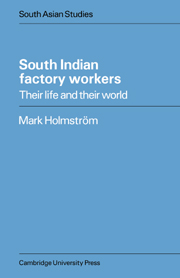5 - The structure of a career
Published online by Cambridge University Press: 06 October 2009
Summary
These shortened accounts of careers show some common themes and contrasts: like the contrast between personal advancement and security, or the theme of the organized sector as a citadel of security and relative prosperity. On the whole these reflect realistic judgments of the situation as I see it.
This chapter is an experiment in analyzing the structure of careers from the workers' point of view, taking their categories and distinctions as a starting point, rather than a description of their situation seen from outside (which would begin with characteristics of the work force, actual recruitment policies, technology etc.). Both approaches are needed if we are to explain action by the logic of the situation, because people's understanding of their situation depends partly on the results of previous actions, and these results depend on whether their assessment of the situation was correct or not. ‘If people define situations as real, they are real in their consequences’; but there is an external, independent reality all the same, and people have to adjust their definitions of what is real as they come up against this reality.
Clearly these typical structures in workers' thought do not represent a consensus on all important questions of fact and value, shared by a ‘society’ or a homogeneous group. They are the gist of many individual accounts, given separately and ad hoc to a stranger in an unfamiliar situation, and grouped according to rough similarities in structure and emphasis and the kinds of situation in which they make sense: what is rational for a skilled middle-class worker to expect is not so for an unskilled man with no chance of promotion; the Lingaayats' cultural heritage affects the way they see their situation; and so on.
- Type
- Chapter
- Information
- South Indian Factory WorkersTheir Life and their World, pp. 122 - 135Publisher: Cambridge University PressPrint publication year: 1976

